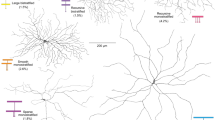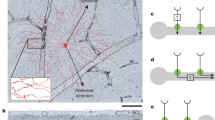Abstract
Directional selectivity to local visual stimuli appears in various levels of the visual pathway, being in the retina very conspicuous. Neurophysiology suggests that directionality (as well as other local and quasi-global filtering properties) are based in the space–time interactions of processes with different “memory” (latency). We draw inspiration from the corresponding underlying biological mechanisms to propose two general schemes for directionality computation in nets, compatible with other space–time filtering properties. First, a connectivistic mechanism based on bipolar–amacrine–ganglion cell interaction is proposed, by formalizing the classical proposals of early vision neurophysiologists. Second, inspired initially in the more recently described intrinsic directionality of amacrines, novel schemes are proposed where directionality appear as the computing consequence of adding memory to spatial filtering structures. The mathematical formulations are achieved by means of Newton Filters and Hermite Functionals.
Similar content being viewed by others
References
Barlow HB, Levick WR (1965) The mechanism of directionally selective units in rabbit’s retina. J Physiol 178: 477–504
Briggman KL, Helmstaedter M, Denk W (2011) Wiring specificity in the direction-selectivity circuit of the retina. Nature 471: 183–188
Dong W, Sun W, Zhang Y, Chen X, He S (2004) Dendritic relationship between starbust amacrine cells and direction-selective ganglion cells in the rabbit retina. J Physiol 556(1): 11–17
Fried SI, Münch TA (2002) Mechanisms and circuitry underlying directional selectivity. Nature 40: 411–413
Fried SI, Masland RH (2007) Image processing: how the retina detects the direction of image motion. Curr Biol 17(2): R63–R66
Hammond P (1973) Contrasts in spatial organization of receptive fields at geniculate and retinal levels: centre surround and outer surround. J Physiol 228: 115–137
Hughes CP, Pearlman AL (1974) Single unit receptive fields and the cellular layers of the pigeon optic tectum. Brain Res 80: 111–122
Keeley PW, Whitney IE, Raven MA, Reese BE (2007) Dendritic spread and functional coverage of starbust amacrine cells. J Comp Neurol 505: 539–546
Leresche N, Hardy O, Jassik-Gerschenfeld D (1983) Receptive field properties of single cells in the pigeon’s optic tectum during cooling of the “Visual Wulst”. Brain Res 267(2): 225–236
Leresche N, Hardy O, Audinat E, Jassik-Gerschenfeld D (1986) Synaptic organization of inhibitory circuits in the pigeon’s optic tectum. Brain Res 365(2): 383–387
Lettvin JY (1962) Form-function relations in neurons. Res Lab of Electron, MIT Quaterly Progress Report. June 1962, 333–335
Li CY, Zhou YX, Pei X, Qiu FT, Tang CQ, Xu XZ (1992) Extensive disinhibitory region beyond the classical receptive field of cat retinal ganglion cells. Vis Res 32(2): 219–228
Marr D Vision (1982) WH Freeman and Company, San Francisco
Martiniuc AV, Knoll A (2011) Sharpening of directional selectivity from neural output of rabbit retina. J Comput Neurosci 30: 409–426
McCulloch WS (1988) Embodiments of mind. MIT Press, Cambridge
Moreno-Díaz R, Rubio E (1980) A model for non-linear processing in cat’s retina. Biol Cyb 37: 25–31
Moreno-Díaz R, Rubio E, Núñez A (1980) A layered model for visual processing in avian retina. Biol Cyb 38: 85–89
Moreno-Díaz R, de Blasio G, Moreno-Díaz A (2008) A framework for modelling competitive and cooperative computation in retinal processing. In: Ricciardi LM, Buonocuore A, Pirozzi E (eds) Collective dynamics: topics on competition and cooperation in the biosciences, vol 1028. American Institute of Physics, New York, pp 88–97
Moreno-Diaz R, de Blasio G (2003) Systems methods in visual modelling. Sys Anal Model Simul 43: 1159–1171
Moreno-Diaz R, de Blasio G (2004) Systems and computational tools for neuronal retinal models. Lect Notes Comp Sci 2809: 494–505
Moreno-Díaz jr R (1993) Computación Paralela y Distribuida: Relaciones Estructura-Función en Retinas. PhD Thesis, Universidad de Las Palmas de GC
Moreno-Díaz R Jr, Quevedo-Losada JC, Quesada-Arencibia A (2000) Systems approach to attention mechanisms in the visual pathway. Lect Notes Comp Sci 1798: 497–505
Pearlman AL, Hughes CP (1976) Functional role of efferents to the avian retina. I. Analysis of retinal ganglion cell receptive fields. J Comp Neur 166: 111–122
Rodieck RW, Stone J (1965) Response of cat retinal ganglion cells to moving visual patterns. J Neurophysiol 28: 819–832
Sterling P (1999) The ganglion receptive field. In: Toyoda J et al (eds) The retinal basis of vision. Elsevier Science B.V., Amsterdam, pp 163–169
Taylor WR, Vaney DI (2002) Diverse synaptic mechanisms generate direction selectivity in the rabbit retina. J Neurosci 22(17): 7712–7720
Taylor WR, He S, Levick WR, Vaney DI (2000) Dendritic computation of direction selectivity by retinal ganglion cells. Science 289: 2347–2350
Tokutake Y, Freed MA (2008) Retinal ganglion cells-spatial organization of the receptive field reduces temporal redundancy. Eur J Neurosci 28: 914–923
Troy J, Shou T (2002) The receptive fields of cat retinal ganglion cells in phisiological and pathological states: where we are after half a century of research. Prog Retin Eye Res 21: 263–302
Tukker JJ, Taylor WR, Smith RG (2004) Direction selectivity in a model of the starbust amacrine cell. Vis Neurosci 21: 611–625
Wei W, Hamby AM, Zhou K, Feller MB (2010) Development of asymmetric inhibition underlying direction selectivity in the retina. Nature 469: 402–406
Yoshida K, Watanabe D, Ishikane H, Tachibana M, Pastan I, Nakanishi S (2001) A key role of starburst amacrine cells in originating retinal directional selectivity and optokinetic eye movement. Neuron 30: 771–780
Author information
Authors and Affiliations
Corresponding author
Rights and permissions
About this article
Cite this article
de Blasio, G., Moreno-Díaz, A. & Moreno-Díaz, R. Bioinspired computing nets for directionality in vision. Computing 94, 449–462 (2012). https://doi.org/10.1007/s00607-012-0186-z
Received:
Accepted:
Published:
Issue Date:
DOI: https://doi.org/10.1007/s00607-012-0186-z




